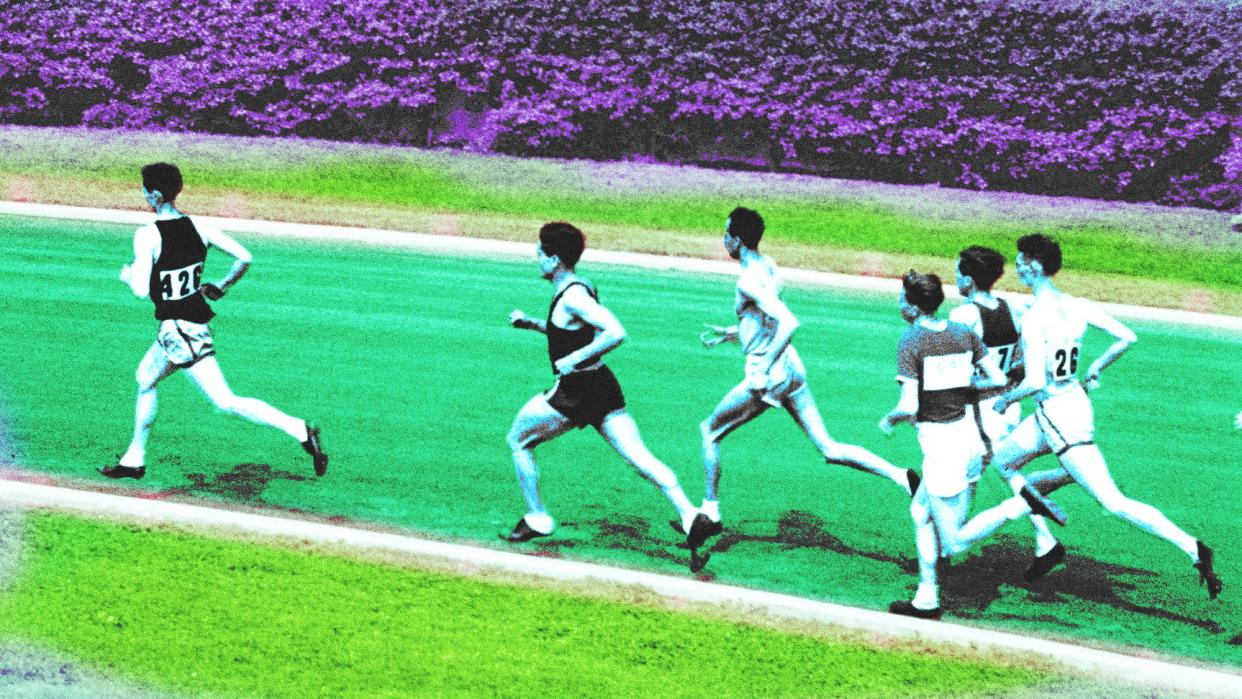Having Asthma Doesn’t Have to Be Your Achilles’ Heel If You Love Cardio—Here’s How to Work Out Hard and Safely

Photograph: Getty Images; Collage: Gabe Conte
Motivational fitness phrases like "no pain, no gain" kind of lose their emphasis when you have a health condition like asthma and are consistently tasked with pushing through discomfort to get a workout in. At its most basic, asthma is a condition wherein the airways narrow, may swell, and produce mucus; breathing becomes difficult, and other side effects may ensue. There are several types of asthma, all of which occur at varying degrees of severity, depending on an individual’s situation. But no matter who you are or what type of asthma you have, spontaneously sprinting a mile might well trigger some symptoms.
When a workout triggers your asthma symptoms—which is more apt to happen with high-intensity and cardio modalities—your best course of action is to pull back in the name of your health. But that doesn’t mean you need to bury your adrenaline-addled, cardio-steeped dreams of cross-country skiing or playing out your point guard fantasies.
Some background on the twin-flame relationship between asthma and exercise: The Centers for Disease Control and Prevention (CDC) estimates that 8 percent of the people in the U.S. have asthma, and for many, exercise can trigger or exacerbate their symptoms. Even if you don’t have asthma and, thus, wouldn’t experience exercise-induced asthma (EIA), you might still be susceptible to a different but related condition called exercise-induced bronchoconstriction (EIB).
The key difference between these two often-confused conditions is that “EIA specifically refers to asthma triggered by exercise, while EIB is a broader term encompassing airway narrowing in response to exercise, which can occur in individuals with or without asthma,” says Payal Gupta, MD, a triple board-certified allergy, asthma, and immunology specialist. This means that if you’re among the 5 to 20 percent of people in the general population who have EIB, you don’t necessarily need to also have symptomatic asthma. (It’s estimated, though, that 90 percent of people with symptomatic asthma do experience EIB.)
Again, none of this means that folks with asthma, EIB, or EIA are meant to completely ditch their dreams of being gym rats. On the contrary, a small 2019 study concluded that aerobic exercise, including muscle training and stretching, three times a week for 30 minutes may help ease asthma symptoms. Another small study found that doing a 20-minute high-intensity interval training (HIIT) workout three times a week might improve asthma symptoms. (Not for nothing, additional research found that HIIT intervention may also reduce feelings of anxiety for folks with asthma.)
While those research conclusions seem promising, they’re based on studies that are narrow and/or reliant on self-reported information. Furthermore, they don’t necessarily account for the nuanced environmental triggers that are classic hallmarks for extinguishing the fitness dreams of someone with asthma.
Making matters murkier is current guidance from official organizations offering advice that could read as wishy-washy or even contradictory to someone with EIB or EIA who wants to know if they can plan on running a marathon. For instance, according to the American Lung Association (ALA), “generally, people with asthma can participate in all types of exercise.” But, over at the American Academy of Allergy, Asthma & Immunology (AAAAI), the recommendations specify that “because cold, dry air can make symptoms worse, as can activities that require continuous exertion, it is recommended that individuals with EIB avoid sports like cross-country skiing, running, soccer, and basketball.”
Both statements hold truth. Developing an asthma management plan with a healthcare provider is key for someone who has EIA or EIB and also loves HIIT (or otherwise exercising in conditions that might trigger asthma symptoms). “Many individuals with EIA or EIB can participate in a range of high-intensity exercises such as marathons, CrossFit, and a variety of sporting activities—even including Olympic sports—if their asthma is controlled,” says John James, MD, a board-certified allergy, asthma, and immunology specialist.
Controlled asthma means “symptoms are minimal or absent, and the person can engage in daily activities, including exercise, without limitations,” says Dr. Gupta. “High-intensity exercise can be problematic if asthma is not under good control, or if triggering factors are not avoided.” So, just as you need to train before expecting to be able to log double-digit miles or practice in order to become skilled at soccer, you have to manage your asthma symptoms in order to safely participate in cardio-heavy or high-intensity exercise.
First on the asthma management list is to pay attention to your environment. Dr. Gupta suggests exercising indoors if you are located somewhere cold, dry, highly polluted, or with a high pollen count. If you still opt for outdoor exercise—and crucially have your doctor’s signoff—make sure to “cover your mouth and nose with a sufficient face mask to warm and filter the air you breathe,” says Dr. James.
No matter where you exercise, a sufficient pre-workout warm-up and post-workout cool-down routine supports the management of asthma symptoms, as does staying hydrated in the midst of your workout. If you’re experiencing excessive or worsening coughing, shortness of breath, increased wheezing, chest tightness or pain, difficulty speaking, lightheadedness or faintness, “these should be warning signs to dial back cardio workouts and high-intensity exercise,” Dr. James adds. From there, seek medical assistance.
“Regular communication with a healthcare provider is essential to adjust the management plan as needed,” says Dr. Gupta. “It's important for individuals with asthma to recognize their limits, prioritize safety, and communicate openly with coaches, trainers, and workout partners about their condition.”
Then, after laying the foundation for medical safety and understanding the triggers to look out for, feel free to hit the pavement or dominate the soccer pitch, basketball court, slopes—or whatever sporting environment your heart (and lungs) desire.
Originally Appeared on GQ

